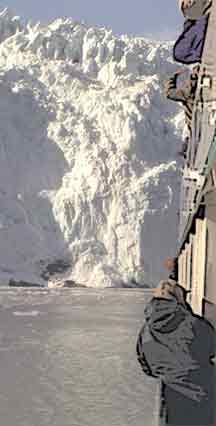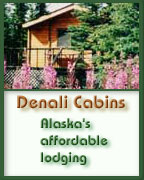 More
than 2 million people visited Alaska's 15 national parks during
the first 10 months of 1999, according to the National Park
Service. The parks can easily handle that many people, however;
Denali National Park and Preserve alone is almost as big as
the state of Massachusetts (Massachusetts has an area of 8,284
square miles, compared with 7,409 square miles for Denali
park).
More
than 2 million people visited Alaska's 15 national parks during
the first 10 months of 1999, according to the National Park
Service. The parks can easily handle that many people, however;
Denali National Park and Preserve alone is almost as big as
the state of Massachusetts (Massachusetts has an area of 8,284
square miles, compared with 7,409 square miles for Denali
park).
Denali National Park and Preserve,
home of North America's tallest mountain -- McKinley, at 20,320
feet -- encompasses 6 million acres. Visitor attractions include
wildlife viewing, mountaineering and backpacking. Some of
the park is open to snowmachines in the winter; the Park Service
is fighting efforts to open up more of the park to them.
Glacier Bay National Park and Preserve
in Southeast Alaska and Kenai Fjords National Park in Southcentral
Alaska are best seen from the water. There is no land access
to Glacier Bay park. Most visitors see it from cruise ships,
though some use air-taxi services from Juneau, 65 miles south
of the park. An airline also provides daily jet service from
Juneau to Gustavus, a town near the park visitors center,
during the summer.
The tourists at right are waiting in their excursion boat
for icebergs to calve off the face of an iceberg in Kenai
Fjords National Park. Several Kenai Fjords cruise
lines operate from the Seward small boat harbor.
Other national parks in Southeast
Alaska include Sitka National Historical Park and
the Klondike Gold Rush National Historical Park.
Sitka Historical Park is the state's oldest national park.
It was created in 1910 to commemorate an 1804 battle. The
park, at 107 acres within a temperate rain forest, is the
smallest in the state. It includes a trail with totem poles,
the site of a Tlingit Indian fort that was burned by Russians
after the 1804 battle, and a Russian bishop's residence built
in 1843. Sitka, once the capital of Russian Alaska, is a coastal
town protected by several small islands.
The Klondike Gold Rush National Historical Park has visitor
centers in Seattle's Pioneer Square and Skagway. The park
includes the White Pass and Chilkoot trails that "stampeders"
took to reach the Yukon gold fields.
In Southcentral Alaska,
there are also the Wrangell-St. Elias, Katmai and Lake Clark
parks and preserves. The Wrangell-St. Elias National Park
and Preserve, at more than 8 million acres, is even larger
than Denali park. It is a wilderness park that includes Mount
St. Elias, at 18,008 feet, the second highest mountain in
the United States (the second highest mountain on the continent,
Mount Logan, is in Canada and is sometimes visible from the
left side of the plane on flights from Seattle to Anchorage.)
This park includes the old copper mining town of Kennicott,
which is now a national historical site.
Katmai National Park and Preserve is famous for its volcanoes.
It includes the Valley of 10,000 Smokes, containing the ash
flow from the 1912 volcanic eruption of Novarupta, the biggest
explosive eruption of the 20th century. In July and September,
salmon runs attract grizzly bears to the Brooks River, Brooks
Lake and Naknek Lake. That in turn brings tourists to Brooks
Camp to view them. Advance reservations are required for Brooks
camp, which is accessible only by small plane.
Portage Glacier in the Chugach National Forest has for years
been one of the most-visited sites in Alaska. Unfortunately,
the glacier at the far end of Portage Lake is receding and
its face can no longer be seen from the Begich, Boggs Visitor
Center at the west end of the lake. The center is still worth
a visit though, for the informational film it shows on Alaska
glaciers. The five-mile drive from the Seward Highway to the
visitor center affords spectacular views of several hanging
glaciers (that is, glaciers that descend partway down a mountain's
side). It is also possible to hike to a glacier from Portage
Lake.
In northwest Alaska,
there are the Gates of the Arctic, Bering Land Bridge, Kobuk
and Noatak national preserves and parks, and Cape Krusenstern
National Monument. Gates of the Arctic is a remote wilderness
park, so remote that it averages only 4,000 visitors annually.
It has no roads or even trails and, at 11,756 square miles,
it is larger than the state of Massachusetts. Access to the
park is generally by air.
The Bering Land Bridge visitor center is in Nome. The preserve
is located on the Seward Peninsula north of Nome. It is accessible
via small bush planes and boat in the summer, and by snowmachine,
dog sleds or small plane on skis in the winter.
The Kobuk, Noatak and Cape Krusenstern parks can most easily
be reached from Kotzebue by air-taxi, watercraft in the summer,
snowmobile in the winter, or by hiking.
In the interior, there's
the Yukon-Charley Rivers National Preserve. The preserve is
a seldom-visited park along the Canadian border in central
Alaska. It averages about 1,500 visits a year, according to
the National Park Service. It includes 115 miles of the Yukon
River and the Charley River basin. It has a number of rustic
cabins and historic sites that date from the 1898 Yukon gold
rush. Access is from the town of Eagle, at the end of the
Taylor Highway.
In the Aleutians, which
were created by a chain of volcanoes, there's the Aniakchak
National Monument and Preserve. This is a 10-square-mile volcanic
caldera that includes lava flows, cinder cones, and explosion
pits, as well as Surprise Lake.
There are many state parks, too, including a Denali State
Park at the southeast corner of Denali National Park. The
most accessible include Chugach State Park, which surrounds
Anchorage on three sides, and Independence Mine Historic Park
in Hatcher Pass, an easy day-excursion from Anchorage.
The National Park Service provides more
information about national parks in Alaska.



